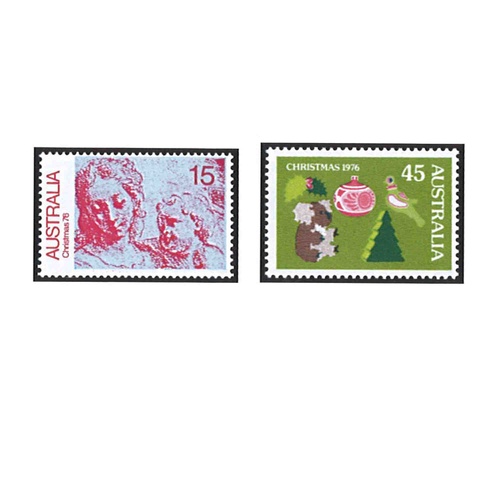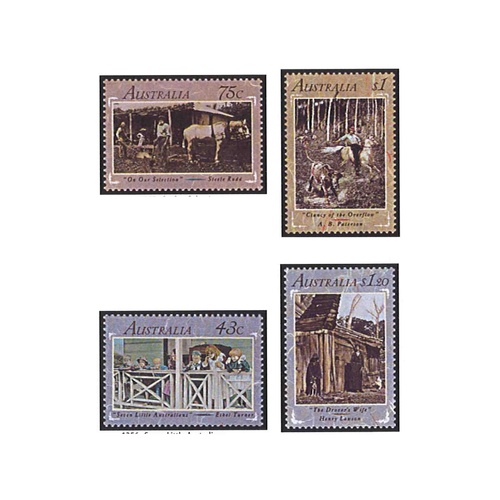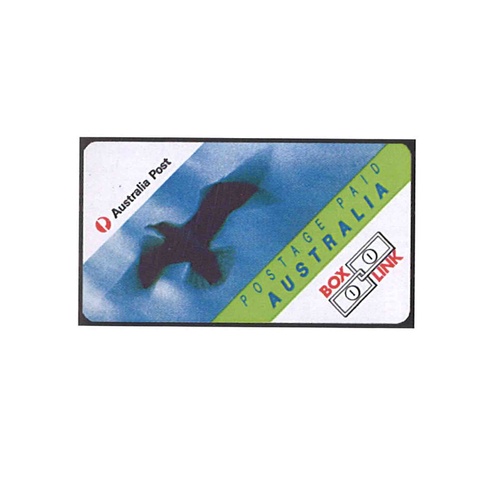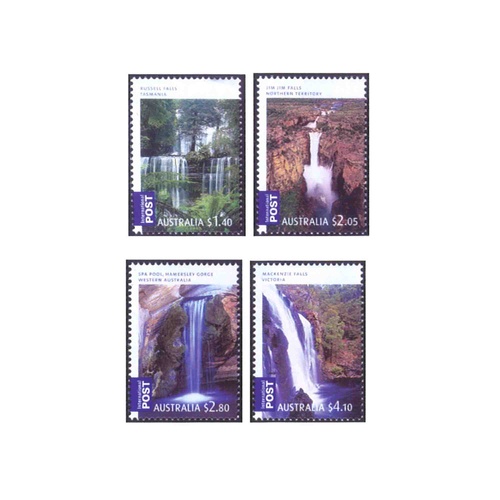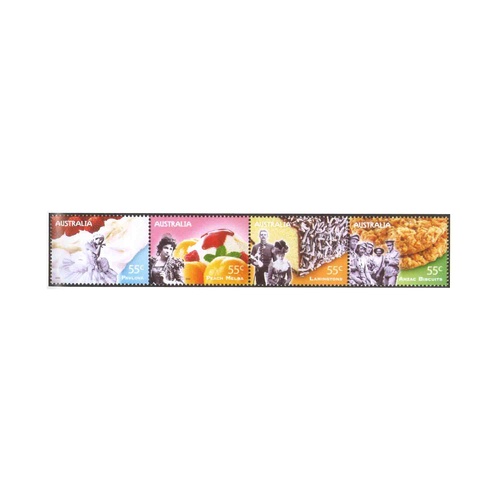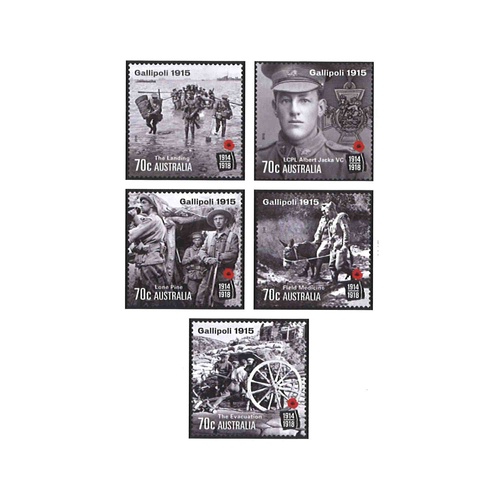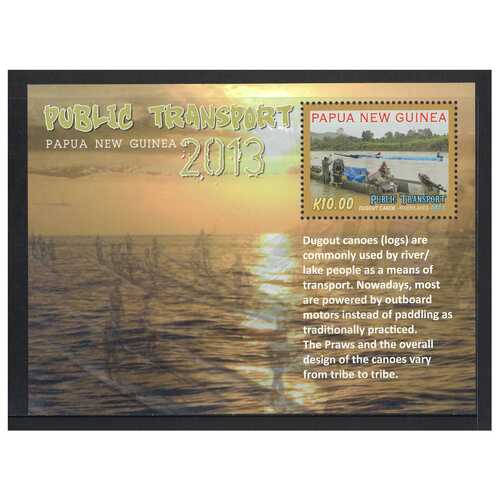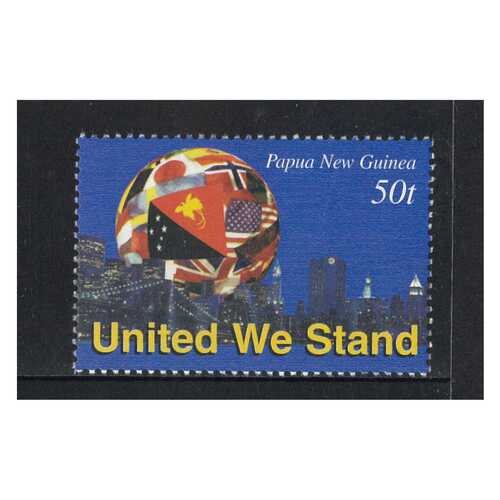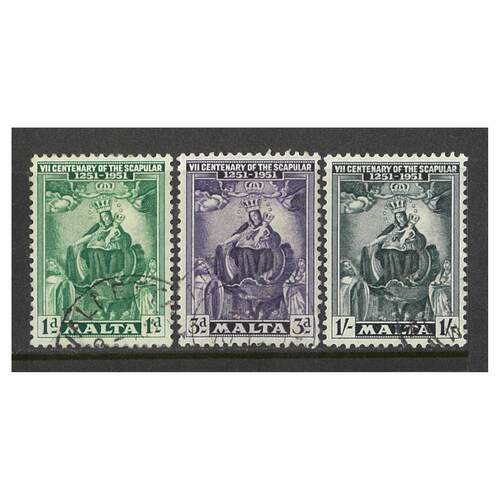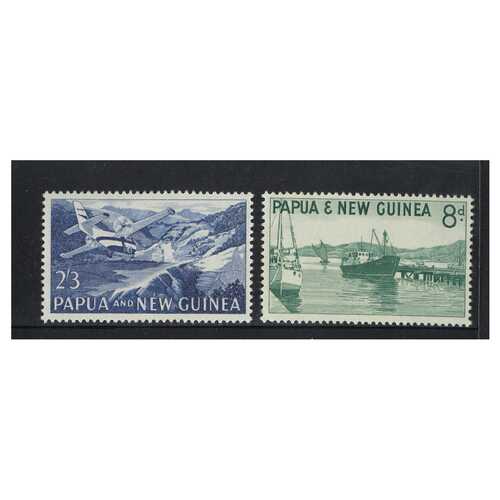Release date: 18 April 2017 This stamp issue is the fourth in a five-year series commemorating World War I, each issue relating to the centenary year in which it is released. The five stamps in this issue, designed by Phil Ellett of Creative Ethos, highlight some key themes and events of 1917: the Australian Flying Corps, which entered the skies above the Western Front in 1917; the costly Third Battle of Ypres; the crucial support for the troops by an army of, largely, women on the home front; the Sinai–Palestine campaign, waged by mounted troops; and the work of war correspondent Charles Bean.
The stamps feature photographs from the Australian War Memorial collection.
At the outbreak of the war, aerial technology was still in its infancy and Australia did not have its own air force. It was, however, the only British dominion to contribute a flying corps. Over the course of the war, the Australian Flying Corps (AFC) sent four squadrons to support British operations during the war. The stamp photograph is by Oswald Hillam Coulson. It shows two Bristol Fighters of the Australian Flying Corps, travelling at top speed to reach their aerodrome before the gathering storm burst.
By the end of 1917, some 40,000 Australian soldiers had been killed or wounded on the Western Front, but this number was nearly doubled by the end of 1917: some 76,836 Australian casualties resulted primarily from the fighting at Bullecourt, Messines and in the Third Battle of Ypres. In fact, between July and November 1917 alone, allied troops lost half a million men in the Third Battle of Ypres – 38,000 of them were Australian. Taken by Frank Hurley, this photograph shows five Australian members of a field artillery brigade, passing along a duckboard track over mud and water among gaunt bare tree trunks in the devastated Chateau Wood, a portion of one of the battlegrounds in the Ypres salient.
Women volunteers are shown here in the Ballroom at Federal Government House in St Kilda Road, Melbourne, which was used by the Red Cross for the storage of goods sent in by local branches. They are sorting and packing items to be sent in parcels to troops. This was the location of the state headquarters of the Australian Red Cross, which formed in 1914, for some of the war years. Besides the Red Cross, many other local organisations and group provided support for troops at the front, and for returned soldiers. The 65,000 sheepskin jackets sent from Australia helped to keep the men warm. Volunteers also knitted thousands of pairs of woollen socks for use in the trenches. Soldiers were instructed to change their socks at least twice daily to help stop outbreaks of fungal trench foot.
During 1917, the campaign against the Ottoman Empire continued in the Middle East. The reorganisation of Anzacs after withdrawal from Gallipoli saw not only the redirection of troops to the Western Front but also the formation of the ANZAC Mounted Division, comprising three brigades of Australian Light Horse, the New Zealand Mounted Rifles as well as the Imperial Camel Corps. In total, five brigades of Light Horse served during the war. In 1916 and early 1917, they secured the Suez Canal and fought at Romani in the Sinai Desert. In 1917, they participated in the advance into Palestine where they fought actions at Gaza, Beersheba and Jerusalem. In 1918, they moved into the Jordan Valley, where they fought at Jericho, Amman and Es Salt, and ultimately entered Damascus later in the year. The stamp photograph by Frank Hurley shows the 2nd Light Horse Brigade passing over sand hills at Esdud, on the Philistine Plain.
In 1914, CEW (Charles) Bean won the Australian Associated Press ballot to become Australia’s official war correspondent, departing for the war in November 1914 with the first contingent of the Australian Imperial Force. The war would come to dominate Bean’s career and life: as well as writing dispatches from the front, he wrote the multi-volume official history of Australia’s part in WWI, he initiated the Australia’s WWI collection, and he conceived of the Australian War Memorial as place to house our national military heritage. During WWII, he again served through his writing, also working in media liaison for the Department of Information. Herbert Baldwin photographed Bean as he watched the Australian advance through a telescope near Martinpuich, France. The photograph was taken on 26 February 1917.
| Shipping Weight | 0.0100kg |
| Shipping Width | 0.100m |
| Shipping Height | 0.010m |
| Shipping Length | 0.100m |
| Assembled Length | 10.000m |
| Assembled Height | 1.000m |
Release date: 18 April 2017 This stamp issue is the fourth in a five-year series commemorating World War I, each issue relating to the centenary year in which it is released. The five stamps in this issue, designed by Phil Ellett of Creative Ethos, highlight some key themes and events of 1917: the Australian Flying Corps, which entered the skies above the Western Front in 1917; the costly Third Battle of Ypres; the crucial support for the troops by an army of, largely, women on the home front; the Sinai–Palestine campaign, waged by mounted troops; and the work of war correspondent Charles Bean.
The stamps feature photographs from the Australian War Memorial collection.
At the outbreak of the war, aerial technology was still in its infancy and Australia did not have its own air force. It was, however, the only British dominion to contribute a flying corps. Over the course of the war, the Australian Flying Corps (AFC) sent four squadrons to support British operations during the war. The stamp photograph is by Oswald Hillam Coulson. It shows two Bristol Fighters of the Australian Flying Corps, travelling at top speed to reach their aerodrome before the gathering storm burst.
By the end of 1917, some 40,000 Australian soldiers had been killed or wounded on the Western Front, but this number was nearly doubled by the end of 1917: some 76,836 Australian casualties resulted primarily from the fighting at Bullecourt, Messines and in the Third Battle of Ypres. In fact, between July and November 1917 alone, allied troops lost half a million men in the Third Battle of Ypres – 38,000 of them were Australian. Taken by Frank Hurley, this photograph shows five Australian members of a field artillery brigade, passing along a duckboard track over mud and water among gaunt bare tree trunks in the devastated Chateau Wood, a portion of one of the battlegrounds in the Ypres salient.
Women volunteers are shown here in the Ballroom at Federal Government House in St Kilda Road, Melbourne, which was used by the Red Cross for the storage of goods sent in by local branches. They are sorting and packing items to be sent in parcels to troops. This was the location of the state headquarters of the Australian Red Cross, which formed in 1914, for some of the war years. Besides the Red Cross, many other local organisations and group provided support for troops at the front, and for returned soldiers. The 65,000 sheepskin jackets sent from Australia helped to keep the men warm. Volunteers also knitted thousands of pairs of woollen socks for use in the trenches. Soldiers were instructed to change their socks at least twice daily to help stop outbreaks of fungal trench foot.
During 1917, the campaign against the Ottoman Empire continued in the Middle East. The reorganisation of Anzacs after withdrawal from Gallipoli saw not only the redirection of troops to the Western Front but also the formation of the ANZAC Mounted Division, comprising three brigades of Australian Light Horse, the New Zealand Mounted Rifles as well as the Imperial Camel Corps. In total, five brigades of Light Horse served during the war. In 1916 and early 1917, they secured the Suez Canal and fought at Romani in the Sinai Desert. In 1917, they participated in the advance into Palestine where they fought actions at Gaza, Beersheba and Jerusalem. In 1918, they moved into the Jordan Valley, where they fought at Jericho, Amman and Es Salt, and ultimately entered Damascus later in the year. The stamp photograph by Frank Hurley shows the 2nd Light Horse Brigade passing over sand hills at Esdud, on the Philistine Plain.
In 1914, CEW (Charles) Bean won the Australian Associated Press ballot to become Australia’s official war correspondent, departing for the war in November 1914 with the first contingent of the Australian Imperial Force. The war would come to dominate Bean’s career and life: as well as writing dispatches from the front, he wrote the multi-volume official history of Australia’s part in WWI, he initiated the Australia’s WWI collection, and he conceived of the Australian War Memorial as place to house our national military heritage. During WWII, he again served through his writing, also working in media liaison for the Department of Information. Herbert Baldwin photographed Bean as he watched the Australian advance through a telescope near Martinpuich, France. The photograph was taken on 26 February 1917.
| SKU | 50945 |
| Shipping Weight | 0.0100kg |
| Shipping Width | 0.100m |
| Shipping Height | 0.010m |
| Shipping Length | 0.100m |
| Assembled Length | 10.000m |
| Assembled Height | 1.000m |


Add your favourites to cart

Select Afterpay at checkout

Log into or create your Afterpay account, with instant approval decision

Your purchase will be split into 4 payments, payable every 2 weeks
All you need to apply is to have a debit or credit card, to be over 18 years of age, and to be a resident of country offering Afterpay
Late fees and additional eligibility criteria apply. The first payment may be due at the time of purchase
For complete terms visit afterpay.com/terms
Copyright © 2026 Max Stern & Co.
ABN: 33 261 090 367
Address: Box 997 GPO, Melbourne VIC 3001 Australia
Welcome to our website. If you continue to browse and use this website, you are agreeing to comply with and be bound by the following terms and conditions of use, which together with our privacy policy govern Max Stern & Co’s relationship with you in relation to this website. If you disagree with any part of these terms and conditions, please do not use our website.
The term ‘Max Stern & Co’ or ‘us’ or ‘we’ refers to the owner of the website whose registered office is 271 Collins Street, Melbourne VIC 3001 Australia. Our ABN is 33 261 090 367. The term ‘you’ refers to the user or viewer of our website.
The use of this website is subject to the following terms of use:
This privacy policy sets out how we uses and protects any information that you give us when you use this website.
We are committed to ensuring that your privacy is protected. Should we ask you to provide certain information by which you can be identified when using this website, then you can be assured that it will only be used in accordance with this privacy statement.
We may change this policy from time to time by updating this page. You should check this page from time to time to ensure that you are happy with any changes.
What we collect
We may collect the following information:
What we do with the information we gather
We require this information to understand your needs and provide you with a better service, and in particular for the following reasons:
Security
We are committed to ensuring that your information is secure. In order to prevent unauthorised access or disclosure, we have put in place suitable physical, electronic and managerial procedures to safeguard and secure the information we collect online.
How we use cookies
A cookie is a small file which asks permission to be placed on your computer's hard drive. Once you agree, the file is added and the cookie helps analyse web traffic or lets you know when you visit a particular site. Cookies allow web applications to respond to you as an individual. The web application can tailor its operations to your needs, likes and dislikes by gathering and remembering information about your preferences.
We use traffic log cookies to identify which pages are being used. This helps us analyse data about webpage traffic and improve our website in order to tailor it to customer needs. We only use this information for statistical analysis purposes and then the data is removed from the system.
Overall, cookies help us provide you with a better website by enabling us to monitor which pages you find useful and which you do not. A cookie in no way gives us access to your computer or any information about you, other than the data you choose to share with us.
You can choose to accept or decline cookies. Most web browsers automatically accept cookies, but you can usually modify your browser setting to decline cookies if you prefer. This may prevent you from taking full advantage of the website.
Links to other websites
Our website may contain links to other websites of interest. However, once you have used these links to leave our site, you should note that we do not have any control over that other website. Therefore, we cannot be responsible for the protection and privacy of any information which you provide whilst visiting such sites and such sites are not governed by this privacy statement. You should exercise caution and look at the privacy statement applicable to the website in question.
Controlling your personal information
You may choose to restrict the collection or use of your personal information in the following ways:
We will not sell, distribute or lease your personal information to third parties unless we have your permission or are required by law to do so. We may use your personal information to send you promotional information about third parties which we think you may find interesting if you tell us that you wish this to happen.
If you believe that any information we are holding on you is incorrect or incomplete, please write to or email us as soon as possible at the above address. We will promptly correct any information found to be incorrect.

